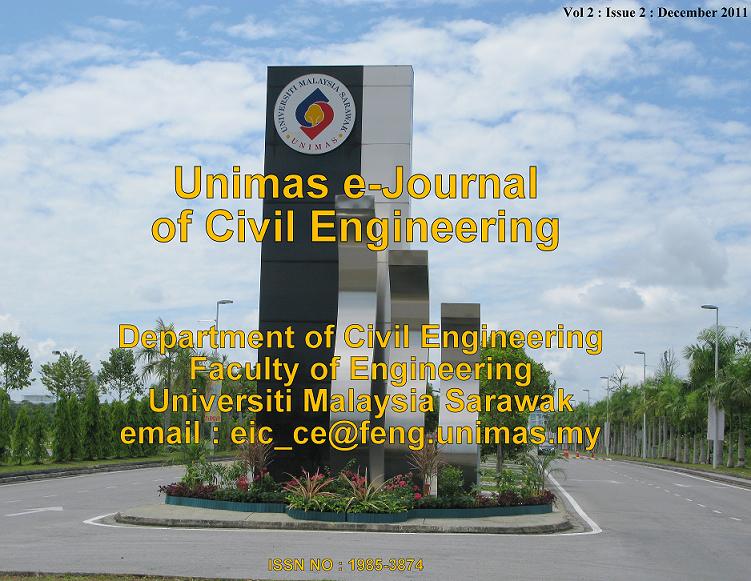The Behavior of Strength Properties from Three Different Tree Boles of Aras in Sarawak
DOI:
https://doi.org/10.33736/jcest.94.2011Abstract
Aras had been selected and tested in small clear specimens. Sampling of test specimens are made from three sections of the tree bole namely from bottom, middle, and top parts. This paper looks into the information of strength properties from three sections of sampled. The strength properties test required are the modulus of rupture, modulus of elasticity and compression stress parallel to grain. Meanwhile, the physical properties' test referred to moisture content and basic density. The testing conducted in two different conditions of the trees, which were referred to green and air-dry condition. It was found that the average mean values for modulus of rupture, modulus of elasticity and compressive stress parallel to grain tested at green condition were 47.52N/mm2, 6358.56N/mm2 and 22.42N/mm2 respectively meanwhile at air-dry condition were 70.49N/mm2, 8217.64N/mm2 and 34.07N/mm2 respectively. Meanwhile, the average mean values for moisture content at green condition were 83.34% whilst at the air-dry condition were 12.33%. Basic density remains unchanged from both conditions.
References
Krishnapillay B. and Abdul Razak Mohd Ali (1998). Feasibility of Planning High Quality Timber Species in Peninsular Malaysia. In Proceeding of the Seminar on High Value Timber Species for Plantation Establishment-Teak and Mahoganies, 1-2 December 1998, Tawau, Sabah. 91-101pp
Anon. (2006). MTC Wood Wizard. Malaysian Timber Council. [WWW5]<http://woodwizard.my/asearch.asp>[Accessed 28 September 2008]
British Standard (1957). Methods of Testing Small Clear Specimen of Timber. British Standard Institution. BS 373: 1957. 31pp.
Anon. (2011). Malaysian Grading Rules, Malaysian Timber Industry Board, (MTIB), (2011). [WWW13]<http://www.mtib.gov.my/index.php?option=com_content&view=article&id=78:malaysia-grading-rules&catid=40:service>[Accessed 2 August 2008]
Richter, H.G. & Dallwitz, M.J., 2000. Commercial timber: descriptions, illustrations, identification, and information retrieval. [WWW16][Accessed 12 Jun 2008]
Keith R. Bootle (1985), Wood in Australia: Type, properties and uses. McGraw-Hill Book Co. Australia. 29, 60-61pp.
R.G. Pearson, N.H. Kloot and J.D. Boyd (1962). Timber Engineering Design Handbook, Jacaranda Press Pty Ltd. Australia, 19, 22-23pp.
Downloads
Published
How to Cite
Issue
Section
License
Upon acceptance of an article, the corresponding author on behalf of all authors will be asked to complete and upload the Copyright Transfer Form (refer to Copyright Issues for more information on this) alongside the electronic proof file.
Copyright Transfer Statement for Journal
1) In signing this statement, the author(s) grant UNIMAS Publisher an exclusive license to publish their original research papers. The author(s) also grant UNIMAS Publisher permission to reproduce, recreate, translate, extract or summarize, and to distribute and display in any forms, formats, and media. The author(s) can reuse their papers in their future printed work without first requiring permission from UNIMAS Publisher, provided that the author(s) acknowledge and refer the publication in the Journal.
2) For open-access articles, the author(s) agree that their articles published under UNIMAS Publisher are distributed under the terms of the Creative Commons Attribution-NonCommercial-ShareAlike 4.0 International License (CC BY-NC-SA 4.0) which permits unrestricted use, distribution, and reproduction in any medium, for non-commercial purposes, provided the original work of the author(s) is properly cited.
3) For subscription articles, the author(s) agree that UNIMAS Publisher holds the copyright or an exclusive license to publish. Readers or users may view, download, print, and copy the content, for academic purposes, subject to the following conditions of use: (a) any reuse of materials is subjected to permission from UNIMAS Publisher; (b) archived materials may only be used for academic research; (c) archived materials may not be used for commercial purposes, which include but not limited to monetary compensation by means of sale, resale, license, transfer of copyright, loan, etc.; and (d) archived materials may not be re-published in any part, either in print or online.
4) The author(s) are responsible to ensure their submitted work is original and does not infringe any existing copyright, trademark, patent, statutory right, or propriety right of others. The corresponding author has obtained permission from all co-authors prior to submission to the journal. Upon submission of the manuscript, the author(s) agree that no similar work has been or will be submitted or published elsewhere in any language. If the submitted manuscript includes materials from others, the authors have obtained permission from the copyright owners.
5) In signing this statement, the author(s) declare that the researches which they have conducted comply with the current laws of the respective country and UNIMAS Journal Publication Ethics Policy. Any experimentation or research involving humans or the use of animal samples must obtain approval from the Human or Animal Ethics Committee in their respective institutions. The author(s) agree and understand that UNIMAS Publisher is not responsible for any compensational claims or failure caused by the author(s) in fulfilling the above-mentioned requirements. The author(s) must accept the responsibility for releasing their materials upon request by Chief Editor or UNIMAS Publisher.
6) The author(s) should have participated sufficiently in the work and ensured the appropriateness of the content of the article. The author(s) should also agree that they have no commercial attachments (e.g. patent or license arrangement, equity interest, consultancies, etc.) that might pose any conflict of interest with the submitted manuscript. The author(s) also agree to make any relevant materials and data available upon request by the editor(s) or UNIMAS Publisher.

